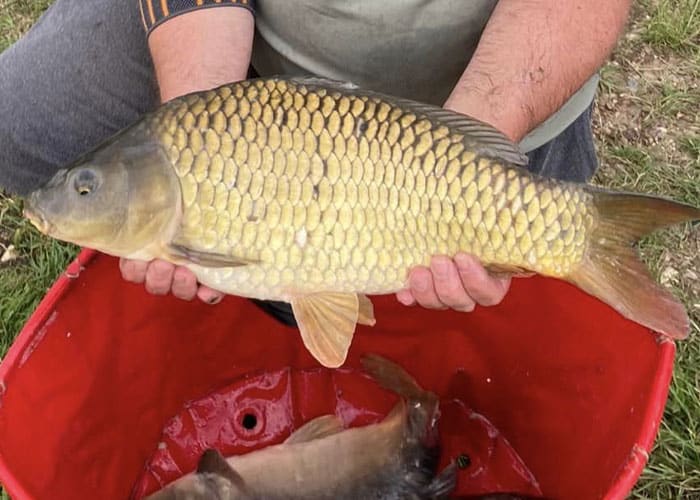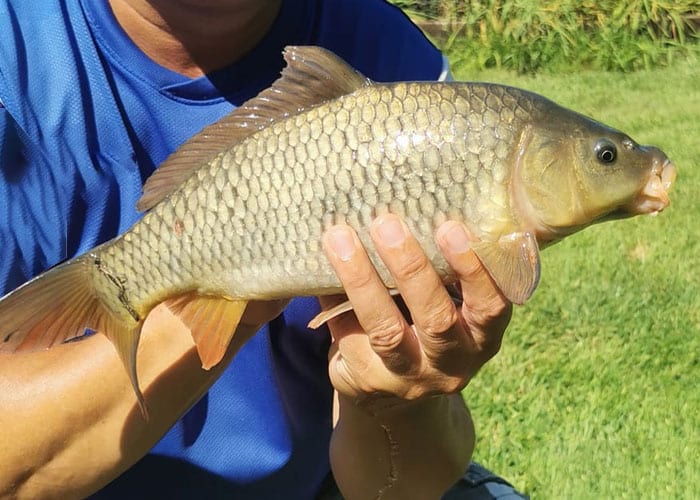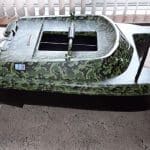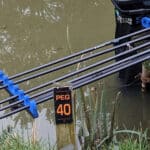For anglers constantly looking to explore new dimensions in their craft, the F1 Carp is a topic of great intrigue. This hybrid species has grown increasingly popular over the years in British waters, gaining the attention of both commercial fisheries and anglers alike. Why? Let’s dive in.
What is an F1 Carp?
Simply put, F1 Carp, also known as F1 Hybrid Carp, is a fascinating crossbreed between the Common Carp and Crucian Carp. They emerged from the dedicated efforts of British fisheries seeking a carp species with unique attributes for stocking in reservoirs and other aquatic habitats.

The F1 Carp carries the best of both worlds. They exhibit physical and behavioural characteristics from both parent species. Like many traditional carp, they are omnivorous, feeding on insect larvae, aquatic plants, and small invertebrates, making them an interesting catch for many anglers.
Identification and Do F1 Carp Have Barbels?
To identify an F1 Carp, there are several key physical attributes to note. They typically bear a golden colour similar to the Crucian Carp, although their body shape leans more towards that of the Common Carp. One interesting feature of the F1 Carp is its barbels, or lack thereof. Do F1 Carp have barbels? The answer is yes, but unlike the Common Carp, which has four noticeable barbels, F1 Carp have two small barbels that are often challenging to spot.
F1 Carp vs. Common Carp Differences
When comparing F1 Carp to Common Carp, some significant differences are evident. For instance, F1 Carp are noticeably smaller than their Common Carp counterparts. They are also more robust, disease-resistant, and active during colder months.
However, the F1 Carp is not just a smaller, hardier version of the Common Carp. They have their unique characteristics and behaviours, including an aggressive feeding pattern, which makes them a favourite catch among many carp anglers.
F1 Carp Record and British Record F1 Carp
Given their smaller size, one might wonder just how big can an F1 Carp grow. The answer surprised angler David Williams, who landed a colossal F1 Carp weighing 13lb 8oz during a carp fishing trip. This catch shattered previous assumptions about the maximum weight of F1 Carp, which typically grows to about 6lb. It set a new British Record for F1 Carp and sparked conversations among the angling community about the potential size of these hybrid carp.
Best Bait for F1 Carp and Best Bait to Catch F1 Carp Shallow
Best Bait for F1 Carp in Spring and Summer
In the warmer spring and summer months, sweetcorn and double maggot baits are the go-to choices for many anglers pursuing F1 Carp. They have found these incredibly effective due to their enticing aromas and bright colours. In shallow water, these baits can work exceptionally well, capturing the attention of F1 Carp cruising near the surface.
The trick to maximizing your success during these seasons is adaptability. Remember, each day on the water may differ, and being flexible with your tactics will always give you an advantage.
Best Bait for F1 Carp in Winter
Winter fishing for F1 Carp presents unique challenges, but you can still catch successfully with the right bait. During the colder months, many anglers have reported success using bread. Its white colour stands out in the water, making it highly visible to the fish, even in low light conditions. Also, single white maggots can be good in the winter.
Lifespan and How Long Do F1 Hybrid Carp Live?
The lifespan of the F1 Carp can vary, just like any other species. Habitat conditions, food availability, and absence of predators can influence how long they live. While the exact lifespan of F1 Carp is still under study, observations suggest they have a lifespan comparable to that of other carp species.
Do F1 Carp Spawn and Are They Sterile?
Do F1 Carp spawn? Like other fish, F1 Carp go through a spawning phase. However, the key thing to note is that F1 Carp are sterile, meaning they cannot produce offspring. This trait is a significant factor for fisheries stocking them as it prevents overpopulation and preserves the ecological balance of the waters.
F1 carp Rigs
A prevalent approach to catching F1 Carp in commercial fisheries is using a pole with a light setup. The battle with an F1 Carp is often less strenuous compared to common or mirror carp; they may bite with force but typically yield more easily once hooked.
If you use maggots as bait, a carbon stem float is an excellent choice for your rig. You should aim to shot the float so that only the smallest tip is visible above the water. F1 Carp are known for their delicate nibbles, and this setup will ensure you spot even the slightest bob of the float, indicating a potential bite. Size 18-hooks would be my recommended size to use.
The advantage of a carbon stem float lies in its capacity to decelerate the descent of the bait, giving the fish more time to notice and approach the descending bait. While maggots are the recommended bait for this setup, casters and pellets are also successful alternatives.
A method feeder full of micro pellets with a 4mm pellet on the hook will also give you a nice days pleasure fishing.
F1 Carp Facts
Despite their popularity, many interesting facts about F1 Carp may surprise even seasoned anglers. For instance, they are known for their strong immunity, including resistance to the Koi Herpes Virus (KHV), which can devastate other carp species, which makes it a great choice for commercial fishery owners. Also, F1 Carp still engage in spawning behaviours despite their inability to reproduce, which can be fascinating.
Conclusion
Understanding the distinctive nature and behaviour of F1 Carp is crucial to successful angling. Each fish species has unique traits; the F1 Carp is no exception. With its unique origins (from a crucian carp and a standard carp), characteristics, and behaviours, the F1 Carp is a testament to the fascinating diversity within carp fishing. Whether you’re a seasoned angler or new to the sport, the F1 Carp offers a unique angling experience, inviting you to deepen your knowledge and appreciation for the rich world of carp fishing.





